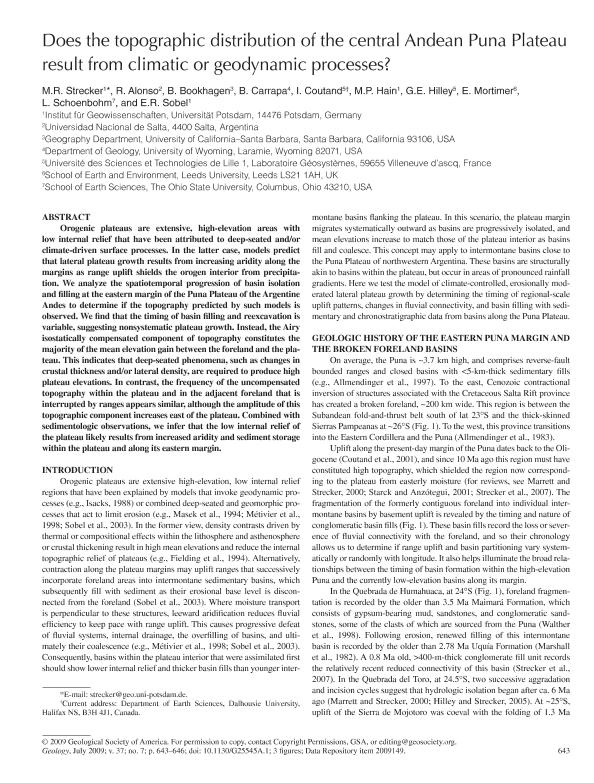Artículo
Does the topographic distribution of the central Andean Puna Plateau result from climatic or geodynamic processes?
Strecker, M. R.; Alonso, Ricardo Narciso ; Bookhagen, B.; Carrapa, B.; Coutand, Isabelle; Hain, M. P.; Hilley, G. E.; Mortimer, E.; Schoenbohm, L.; Sobel, E. R.
; Bookhagen, B.; Carrapa, B.; Coutand, Isabelle; Hain, M. P.; Hilley, G. E.; Mortimer, E.; Schoenbohm, L.; Sobel, E. R.
 ; Bookhagen, B.; Carrapa, B.; Coutand, Isabelle; Hain, M. P.; Hilley, G. E.; Mortimer, E.; Schoenbohm, L.; Sobel, E. R.
; Bookhagen, B.; Carrapa, B.; Coutand, Isabelle; Hain, M. P.; Hilley, G. E.; Mortimer, E.; Schoenbohm, L.; Sobel, E. R.
Fecha de publicación:
07/2009
Editorial:
Geological Society of America
Revista:
Geology
ISSN:
0091-7613
Idioma:
Inglés
Tipo de recurso:
Artículo publicado
Clasificación temática:
Resumen
Orogenic plateaus are extensive, high-elevation areas with low internal relief that have been attributed to deep-seated and/or climate-driven surface processes. In the latter case, models predict that lateral plateau growth results from increasing aridity along the margins as range uplift shields the orogen interior from precipitation. We analyze the spatiotemporal progression of basin isolation and filling at the eastern margin of the Puna Plateau of the Argentine Andes to determine if the topography predicted by such models is observed. We find that the timing of basin filling and reexcavation is variable, suggesting nonsystematic plateau growth. Instead, the Airy isostatically compensated component of topography constitutes the majority of the mean elevation gain between the foreland and the plateau. This indicates that deep-seated phenomena, such as changes in crustal thickness and/or lateral density, are required to produce high plateau elevations. In contrast, the frequency of the uncompensated topography within the plateau and in the adjacent foreland that is interrupted by ranges appears similar, although the amplitude of this topographic component increases east of the plateau. Combined with sedimentologic observations, we infer that the low internal relief of the plateau likely results from increased aridity and sediment storage within the plateau and along its eastern margin.
Archivos asociados
Licencia
Identificadores
Colecciones
Articulos(CCT - SALTA-JUJUY)
Articulos de CTRO.CIENTIFICO TECNOL.CONICET - SALTA-JUJUY
Articulos de CTRO.CIENTIFICO TECNOL.CONICET - SALTA-JUJUY
Citación
Strecker, M. R.; Alonso, Ricardo Narciso; Bookhagen, B.; Carrapa, B.; Coutand, Isabelle; et al.; Does the topographic distribution of the central Andean Puna Plateau result from climatic or geodynamic processes?; Geological Society of America; Geology; 37; 7; 7-2009; 643-646
Compartir
Altmétricas



